TWO MONTHS AT THE LOTUS TEMPLE

This is my story of serving as a volunteer in the Baháʼí House of Worship in Bahapur, New Delhi. There were so many incredible events and quite unbelievable anecdotes while I was serving there, and they shall forever be etched in my memory. I had heard many wonderful stories about this magnificent edifice and desired to witness for myself the greatness of the temple that was praised by so many visitors and its architectural marvels appreciated by many renowned organizations across the globe. A window of opportunity opened for me during the months of October and November in 2022. Two other friends from Malaysia – Mageswaren and Gunasegaran joined me to serve as volunteers in the Baháʼí House of Worship. What I am writing here is my own observation of what I saw, and heard of the temple while I served there.
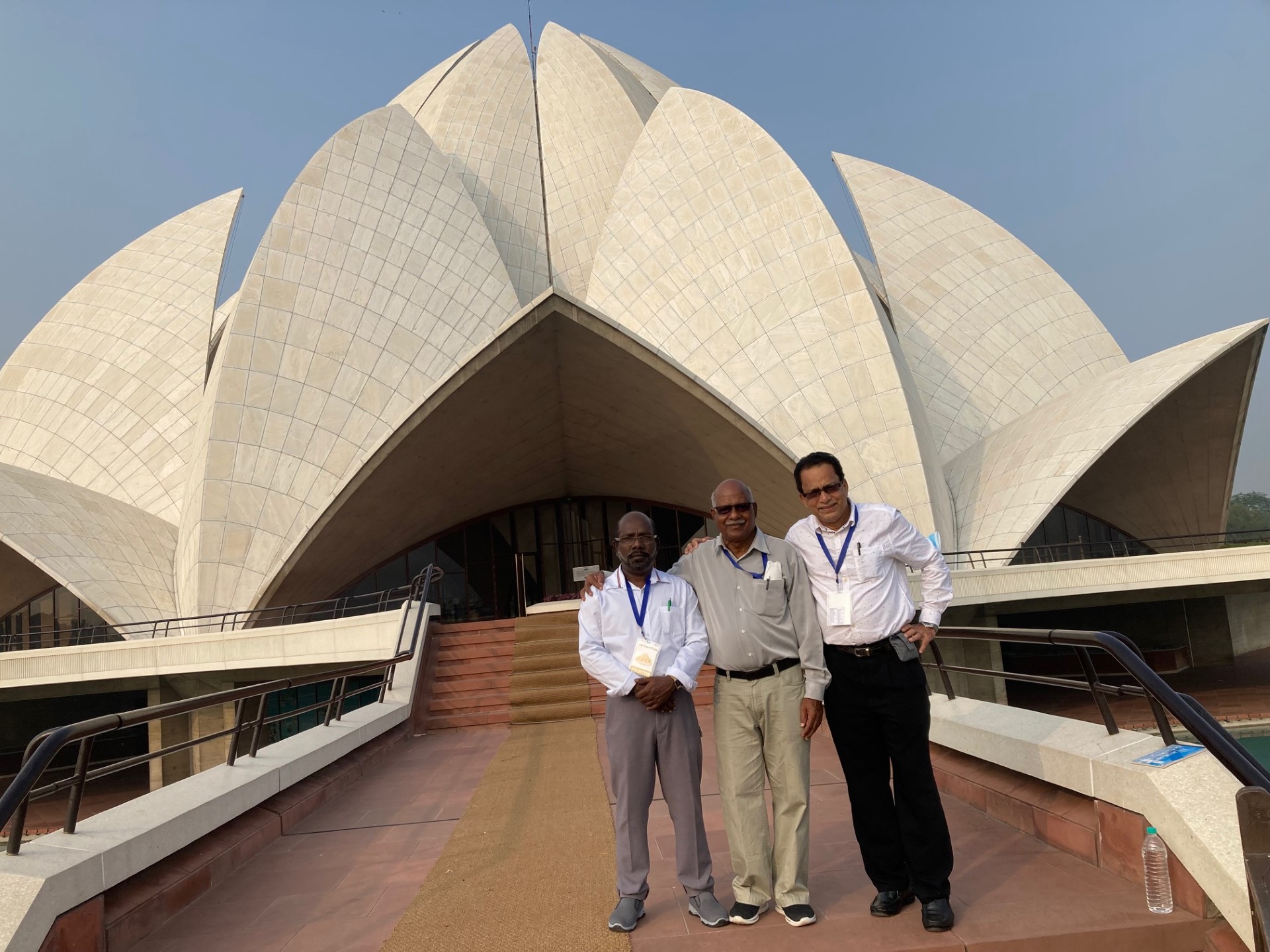
The volunteers from Malaysia. (L-R) Gunasegaran, Y. Mari and Mageswaren.
A BRIEF BACKGROUND
I stepped into the temple premises with little knowledge of the temple. But on arrival, we volunteers were told to get into all the details of the temple, ranging from its genesis to the latest information. I had to get hold of all information available mainly from the abundant literature available at the library that is on the ground floor of the temple. And true enough, it was after arriving as a volunteer that I had the bounty of knowing so much about the background details of the Baháʼí House of Worship based on the literature available in the library which contains more than 2000 different titles in 111 languages. The Bahá’í House of Worship is referred to as Mashriqu’l-Adhkár in the Arabic language in the Baháʼí Writings with the meaning of “Dawning Place of the Praise of God”. The Bahá’í House of Worship is an integral part of Bahá’í community life and in the future, there will be national and local houses of worship erected wherever Baháʼís resided. While that is for the future, for the moment we have a few temples across the globe.
The genesis of the temple in New Delhi began with one humble believer. There was one Baháʼí by the name of Ardishír Rustampúr in Hyderabad, who donated his life savings in his Will toward building a new temple. Today there is a photograph of him hung in the dining hall of the dormitory in the temple grounds. With that reserve, the Baháʼís purchased a piece of land in the Bahapur village of New Delhi in the year 1953. Voluntary donations poured in from other Baháʼís of India and the process of getting the building erected started off in 1976. The Iranian-born Canadian architect by the name of Fariborz Sahba went around India to select the design. He chose the lotus flower as the design. The lotus is a symbol of beauty, purity, and divinity intimately associated with many religions in India. It is the shape of the lotus flower that made the public refer to it as the Lotus Temple or the Kamal Mandir in Hindi. Roads leading to the temple in New Delhi have several road signs reading “Lotus Temple” or “Kamal Mandir”. This has become a household name in New Delhi and by extension India as well. The name is also on the lips of international visitors. All taxi and autorickshaw drivers from any part of New Delhi need to be told of Kamal Mandir and they do not ask further questions. To the believers of the Baháʼí Faith, this glorious edifice is a House of Worship, but the generality of the people calls it a temple.
Hand of the Cause of God Amatu’l-Bahá Rúhíyyih Khánum, representing the Universal House of Justice, laid the foundation stone on 17 October 1977. The construction started in 1980 with a 800 workforce and it was dedicated on 24 December 1986 by Amatu’l-Bahá again representing the Universal House of Justice. Hands of the Cause of God William Sears and Collis Featherstone were also present during the dedication ceremony. In January 1987, the magnificent edifice was opened to the public. The Baháʼí House of Worship today stands out most majestically on 27 acres of beautifully landscaped lush gardens. The temple is a circular shape with nine sides and nine entrances and is encircled by nine pools as well. The pools help in the ventilation of the prayer hall. As fresh air is cooled as it passes over the fountains and pools, it is drawn in through openings in the basement up into the central hall and expelled through a vent at the top of the structure. This keeps the interior cool even during the hottest months of the year. The pools also enhance the beauty of the House of Worship.
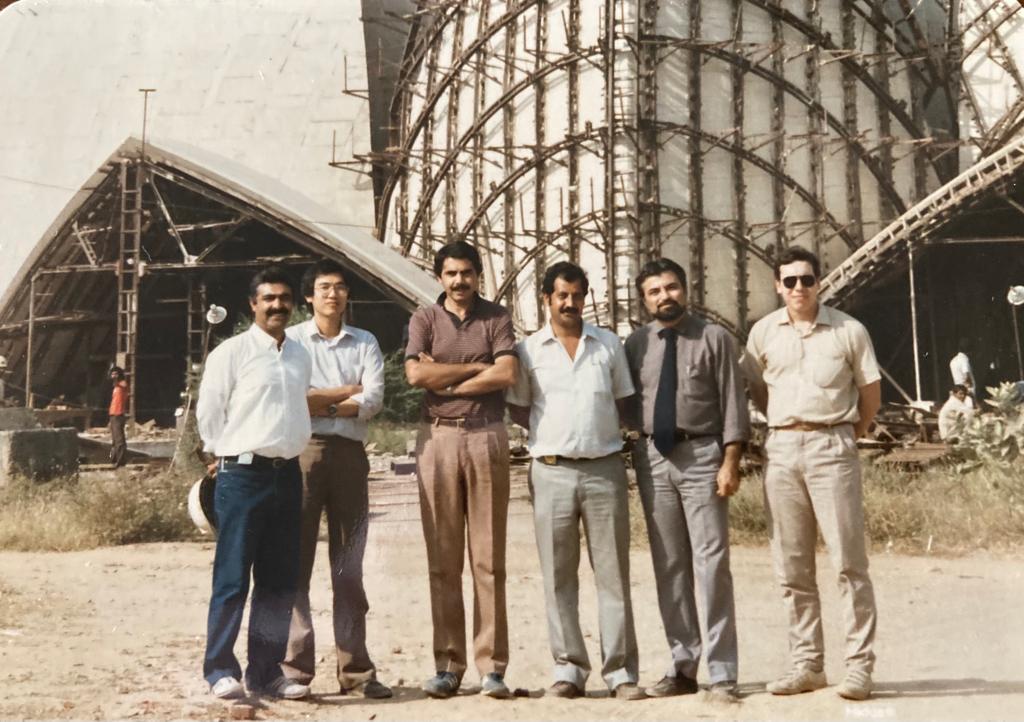
A 1985 photo of the Baha’i team supervising construction of the Temple: (L-R) Masood Fani, Lim Woon Hun, Mashiyat Ashraf, Ezzat Hosseini, Fariborz Sahba (Architect of the Temple) and Kamal Fozdar.

Amatu’l-Bahá Rúhíyyih Khánum at the dedication of the temple in December 1986 (Copyright © Bahá’í International Community)
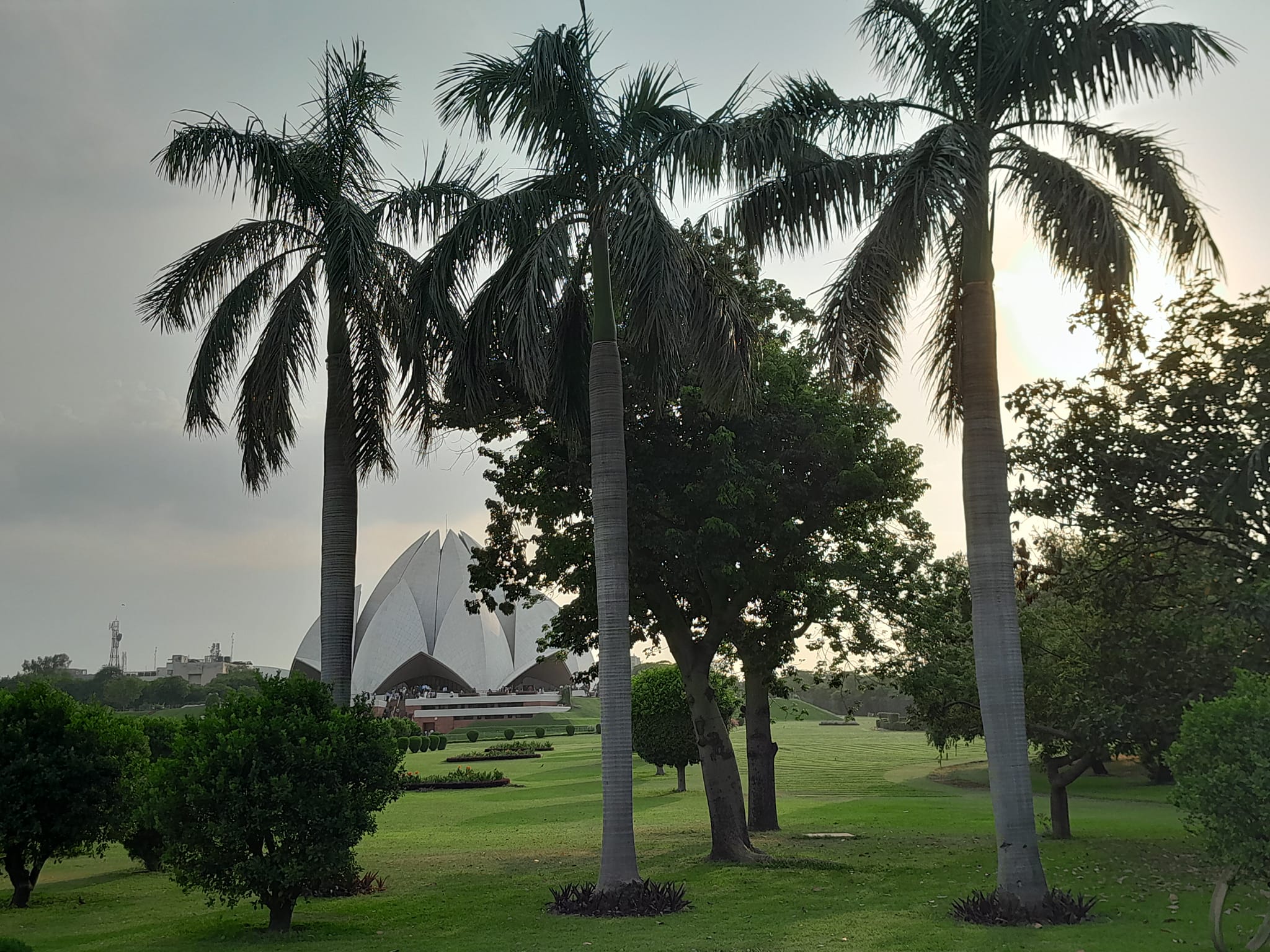
The first full view as one enters from the main entrance.
The temple complex consists of an ancillary block with a reception centre, a library, and an administrative office, all of which I visited during my stay there. This temple is about the first to use solar power. The temple is constructed primarily of concrete and clad in marble from Greece. The temple is one of eight continental Bahá’í Houses of Worship in the world and the only one I have visited and served as a volunteer thus far. The Baha’i House of Worship in New Delhi is one of the iconic landmarks of this city and is the “Mother Temple” of the Bahá’í Faith in the Indian subcontinent. With people belonging to all religions, castes, creeds, and races coming together to sit side by side and pray, the temple truly represents its purpose, that is to represent the principles of the Oneness of God, the Oneness of all Religions, and the Oneness of Mankind, which are the basic teachings of the Bahá’í Faith.
Temple on top and administrative complex at the ground level.
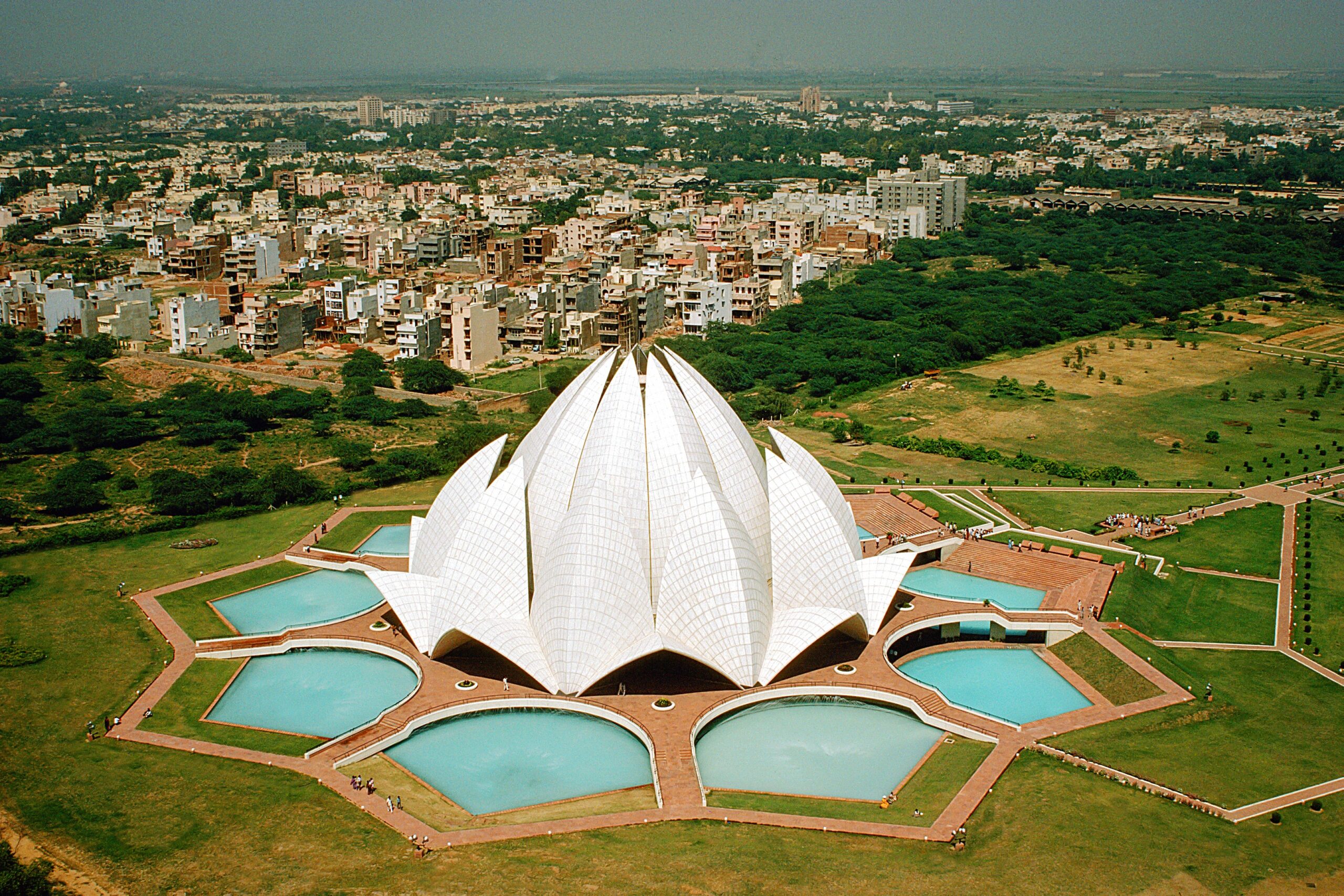
An aerial view (Copyright © Bahá’í Aerial International Community)
I witness during my service that this House of Worship attracted a very large number of visitors from India and abroad, and on weekends visitors may even cross more than one hundred thousand, thus making this one of the most visited temples in the world. Visitors arrived by the nearby Kalkaji Mandir Metro Station, tourist buses, private and hired cars, auto rickshaws, and motorcycles. These are about the basic information I gathered when I arrived. This is not exhaustive information as there are many more interesting information. For the purpose of my story, I feel this much information would suffice for now.
ROUTINE STARTS
Having never served in any Bahá’í temple before, I had no clue as to what to expect. But upon arrival, I was greeted by several pleasant experiences. Volunteers were given the freedom to select one of the many areas of service – gardening, information desk, temple service, housekeeping, and security. I selected temple service, as I thought I could meet many visitors from various parts of the world.
As I arrived at the temple premises, I was checked into the men’s dormitory and shared a room with my two other friends from Malaysia. Most of the volunteers came from India, and some from abroad as well. We became instant friends, and the bond lasts till today. The dormitories for men and ladies are separated with a dining hall in between. It was during meal times and the evenings that we socialised, apart from the time we were serving in the temple premises.
After breakfast on the next day, I was taken to meet the General Manager of the temple and the senior management team who all gave me a briefing on how to serve as a volunteer in the most effective manner. The next day we had to study a document on “Joy of Service” which carried selections from the Bahá’í Writings about service for the Cause, including serving in the temple. Then I set off to start my service. The first part was observing what the senior volunteers were doing, and I learnt from them quite fast. On the second day, I arrived at the temple at 8:00 in the morning. At 8:00 am sharp the main gate was open to the public, and there came wave after waves of visitors. The security at the main gate ensured that all bags were screened to prevent the visitors from bringing any alcoholic beverages, food items, and cigarettes, bearing in mind they were entering a holy ground. When I happened to be at the main entrance gate some days later, I observed something that touched me. As soon as the visitors entered the temple ground and had the first sight of the temple, they reverently raised their hands and clasped their palms to show their devotion to God. The temple is not only a holy place but had an indescribable beauty to behold. No pen could describe, nor any tongue narrate that inexplorable beauty. Unable to resist the verdant beauty they would start taking photos from various places and in various angles, within the permitted areas. The temple is surrounded by greeneries of beautiful gardens. Different seasons have different flowers blooming, thanks to the gardeners who maintain a large nursery with the best flowers India could provide. The visitors would walk on the pristine walkway leading to the stairs of the temple.

The crowd approaches the temple very early in the morning.
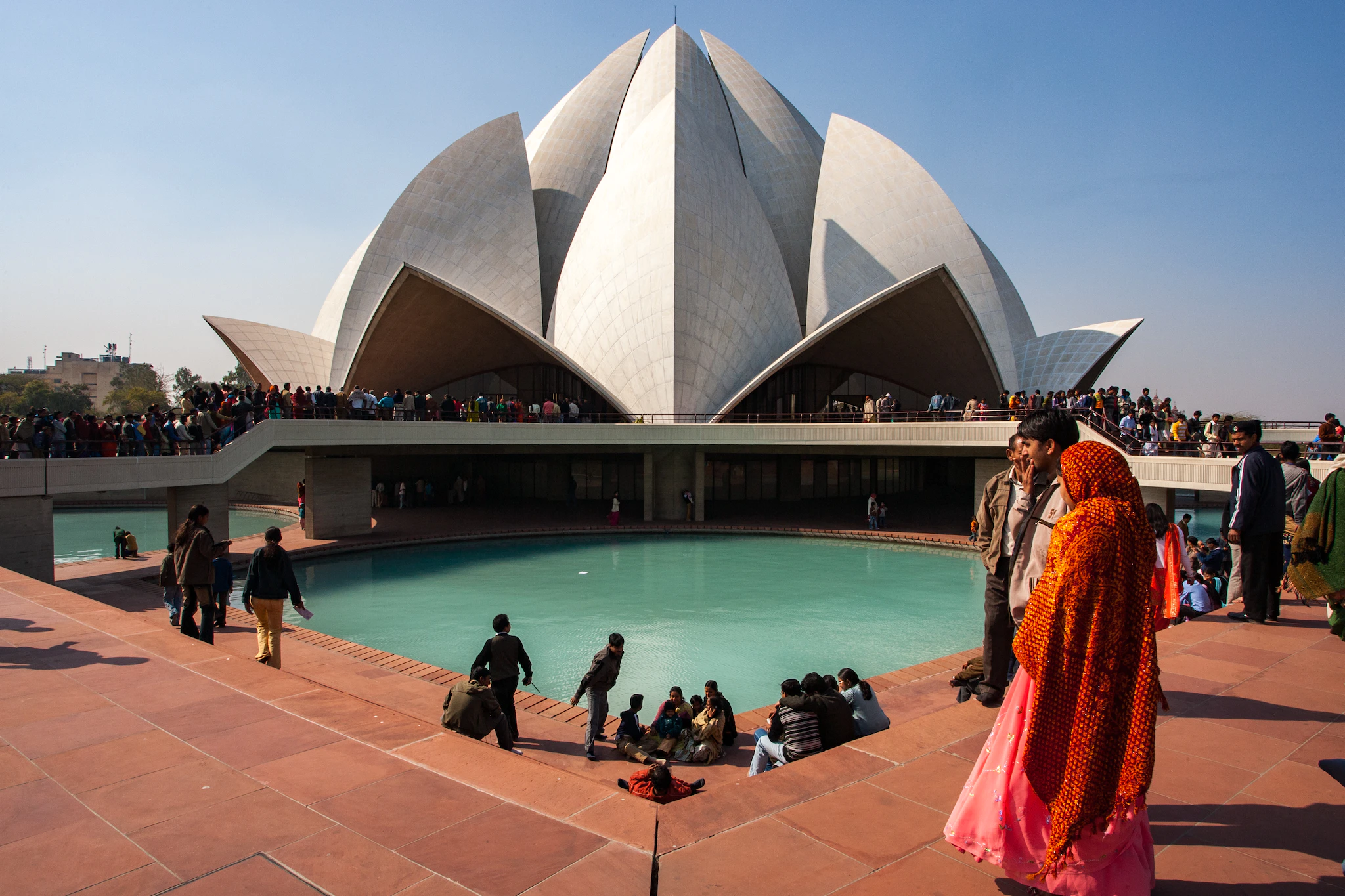
At the pool after the temple visit. (Copyright © Bahá’í International Community)
I was getting ready at the temple to assist them. Assistance ranged from welcoming visitors at the stair of the temple, while at the same time counting the number of visitors with the help of a simple gadget. As they approached the entrance of the temple, I would request them to line up near the entrance and finally brief them on what was expected of the visitors. I had to inform them of the sanctity of the temple and requested them to remain absolutely silent in the prayer hall and refrain from taking photographs or videos. The briefing is normally given in Hindi and English. I would brief in English while another volunteer gave the briefing in Hindi. Since I could converse in Telugu and Tamil languages, there were moments when I gave the briefings in these languages too. After the briefing, the doors were opened for them to enter into the prayer hall. The prayer hall is plain and has no altars or religious idols, pulpits, or fixed speaker platforms. There are no rituals or ceremonies. No talks or sermons are delivered. To many, this was something unexpected and new. The prayer hall has a capacity for 1,300 visitors to be seated on the benches. There is capacity to increase the number to 2,500. At some moments, I too served inside the prayer hall, to ensure there was tranquillity. Visitors were allowed to remain in the prayer hall for as long as they desired. Special prayer services are held four times throughout the day at 10:00 am, 12:00 noon, 3:00 pm, and 5:00 pm. During these prayer sessions that last for about ten minutes, scriptures from various religions were read out or chanted in melodious voices. I had the privilege of chanting the Lord’s Prayer taken from the Holy Bible. The prayer sessions were a novelty to the visitors. They have never seen people from different religious groups sitting side by side and praying together. I too witnessed this only at this Baháʼí House of Worship. Some stayed on for a long time, praying and meditating with tearful eyes! Some brought their prayer beads to chant the mantras of their religions within their hearts. That all people of all religions came together to pray in a common place reminded me of what ‘Abdu’l-Bahá, eldest son of Bahá’u’lláh – the Prophet Founder of the Bahá’í Faith has said: “Bahá’u’lláh has commanded that a place of worship be built for all the religionists of the world; that all religions, races and sects may come together within its universal shelter; that the proclamation of the oneness of mankind shall go forth from its open courts of holiness.”
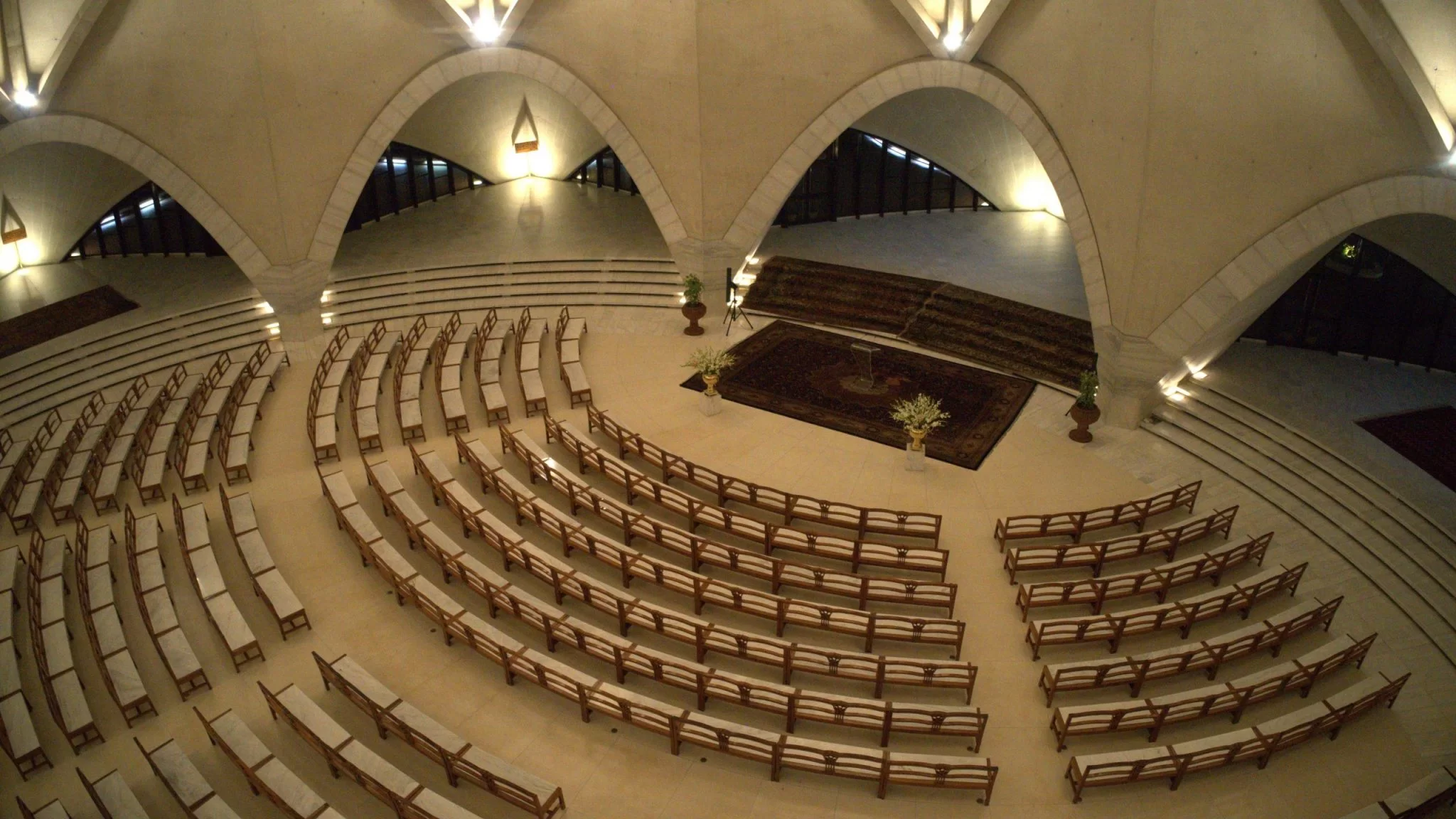
Prayer Hall (Copyright © Bahá’ís of India)
Even atheists could feel the peace, positive energy, and serenity the prayer hall offers. It was a sight to behold, people paying so much reverence and respect in the prayer hall. There were many who had come for the first time, while there were others who were repeat visitors, all because of an unknown attraction in the temple. Many of those who came out of the prayer hall were very appreciative of the serene, calm, and spiritual atmosphere in the temple.
As the visitors came out of the prayer hall, they usually had many questions which were answered by volunteers at the visitors’ desk placed outside the exit door. Some frequently asked questions were like why there was no deity or idols inside the prayer hall, who financed the construction of the temple, and who funds its maintenance. Some even asked politically inclined questions, which I avoided answering as Baháʼís are refrained from getting involved in politics or political discussions while maintaining loyalty to the governments. It was surprising too that some asked, after exiting from the temple, what the temple is all about. Apparently, they did not come on their own accord but were brought by tourist agencies. There were some tourist agents who, having come to the temple numerous times were well-informed of the tenets of the Faith and they answered their questions if any, right in my presence. The visitors’ desk had a stock of pamphlets describing the temple and the Baháʼí Faith in so many languages and pamphlets would be given to them in the languages they preferred. This desk was meant to give the basic information on the Faith and there was no intention of any religious propaganda at all. We were careful in not to coerce them in any way to accept the Baháʼí Faith.
Admittedly, sometimes dealing with some visitors was highly challenging. We were briefed that visitors are to be seen as guests of Bahá’u’lláh. The words of ‘Abdu’l-Bahá were a reminder to us: “See ye no strangers; rather see all men as friends, for love and unity come hard when ye fix your gaze on otherness … For each of the creatures is a sign of God, and it was by the grace of the Lord and His power that each did step into the world; therefore, they are not strangers, but in the family; not aliens, but friends, and to be treated as such.” On the other hand, some refused to follow simple rules like observing silence or refraining from taking photographs. I had to explain to them with all patience that respect, and reverence had to be accorded to this holy place. On many instances, they adhered to the request. Irrefutably, there were also difficult visitors whom the volunteers had to tolerate.
Serving in the temple was highly demanding and with a lot of challenges. Each day had its own challenges. Every day was a learning experience for me. It was the routine for me to get up early in the morning and go for dawn prayers at the temple. After that, I returned to the dining hall for breakfast. After breakfast, I was at the temple at about 8:00 am. After serving the whole day I would return to the dormitory at about 6:30 pm in the evening. At least two days in a week we used to have reflection meetings with the General Manager of the temple after dinner time. During the reflection meetings, we discuss problems and issues faced while serving, and the right solutions are decided – all for the sake of providing the best services at the temple. It needs to be mentioned that the management, senior staff, and volunteers work in unison.
There were two tea breaks in the morning and the afternoon lasting for fifteen minutes. Lunchtime was for 45 minutes. There was no time to relax from morning to evening. Most of the time we had to serve actively and attentively, rising to unexpected situations. Yet I did not feel the time passing, and all thoughts of difficulties vanished. While immersed in the service, I was oblivious to all my personal problems. When immersed in service to God, I surrendered myself to my Creator. When one takes care of the Cause of God, God will certainly take care of our cause. I accepted that as the irrefutable truth. On every Sunday morning, we have dawn prayers participated by the volunteers and the local believers from nearby areas. Baháʼí Holy Days are also celebrated among the Baháʼís on the temple premises. Mondays are our off days during which we will go for outings, shopping or visiting friends in the city and attend to our laundry work. It’s a totally free day for the volunteers.
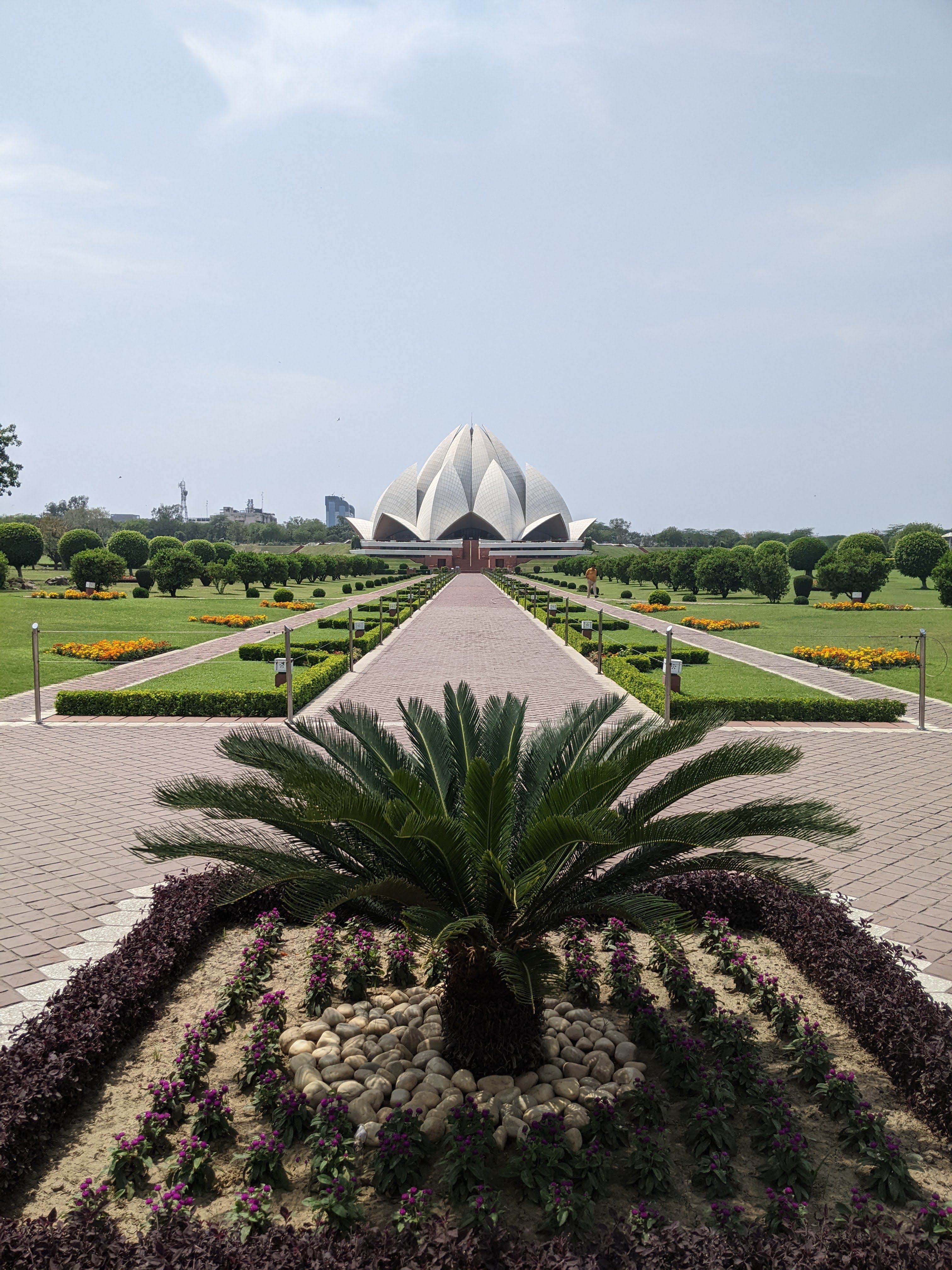 As the temple appears on any Monday-off day. Simply serene and calm.
As the temple appears on any Monday-off day. Simply serene and calm.
RAIN OR SHINE
There were sights that were unbelievable to me. While the winter months between October and March are said to be the best time to visit the temple owing to pleasant weather, people flock into the temple all year round. I was told thousands would rush into the temple during mid-summer in the scorching heat of the sun. The situation was the same when I was serving in the cold months of October and November. The visitors were often the local population of Delhi, who could have come in cool spring or autumn. But surprisingly they came voluntarily in winter. There were infants, toddlers as well as aged people, some unable to walk owing to health issues. They all came to pray in the temple, though not believers in the Bahá’í Faith. The greatness of the visitors lies in that they loved and respected all the religions that abound in the great Indian sub-continent. This integral aspect was well demonstrated in the temple.
During this winter there was one unusual rainy day. It poured like cats and dogs, as people say. Yet people came continuously, getting completely drenched and walking straight to the stairs of the temple, some with infants in their hands. Since they were completely drenched, the prayer hall was closed to avoid dampness in the temple. Some visitors were sad and disappointed. They urged to be allowed saying that they were coming to the temple for the first time, and they came from faraway places. An elderly lady broke down and begged to be allowed inside the prayer hall. She was taken to a shelter below the temple and told to rest there on the promise that she will be allowed into the prayer hall when the rain stopped. One hour later the rain stopped and by then it was already six in the evening. The main entrance gate was closed at that time. But this lady still stayed on. Seeing that she was sincere and very spiritually inclined she was taken into the prayer hall and allowed to pray. After about twenty minutes, she came out with bloodshot eyes. She must have cried in the hall! She was then accompanied to the main exit gate as a mark of respect for the reverence displayed in the prayer hall. It needs to be mentioned that there was open appreciation from many visitors, who were surprised and appreciative of the fact that all or almost all the volunteers were teenagers. To them, temple workers were usually elderly people with grey hairs or balding heads. They saw the contrary here.
Perhaps it is this unexplained beauty that keeps some visitors within the temple premises from morning till dusk. Some of them go out for their meals, in the eating places just outside the temple gates and return to remain in the temple premises until the main gate closes. While the visitors are not allowed to go into the open gardens, they sit on the basement of the temple, closest to the pools, some having peaceful naps. There is a large washroom in the temple premises, big enough to accommodate any number of visitors. It is being very well maintained for its cleanliness. Next to the washroom, there is also a supply of drinking water.
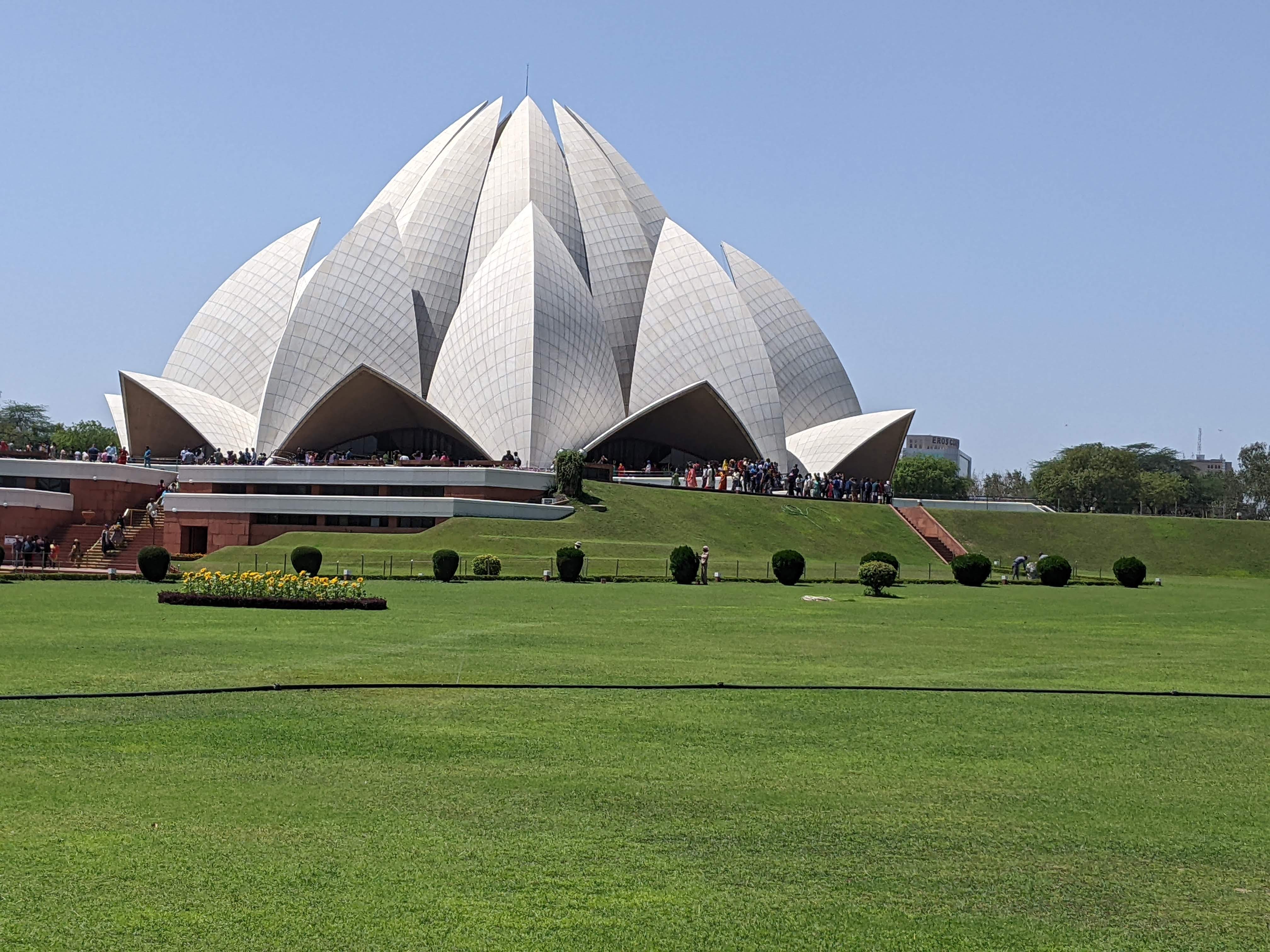
View of the Temple at Mid-day.
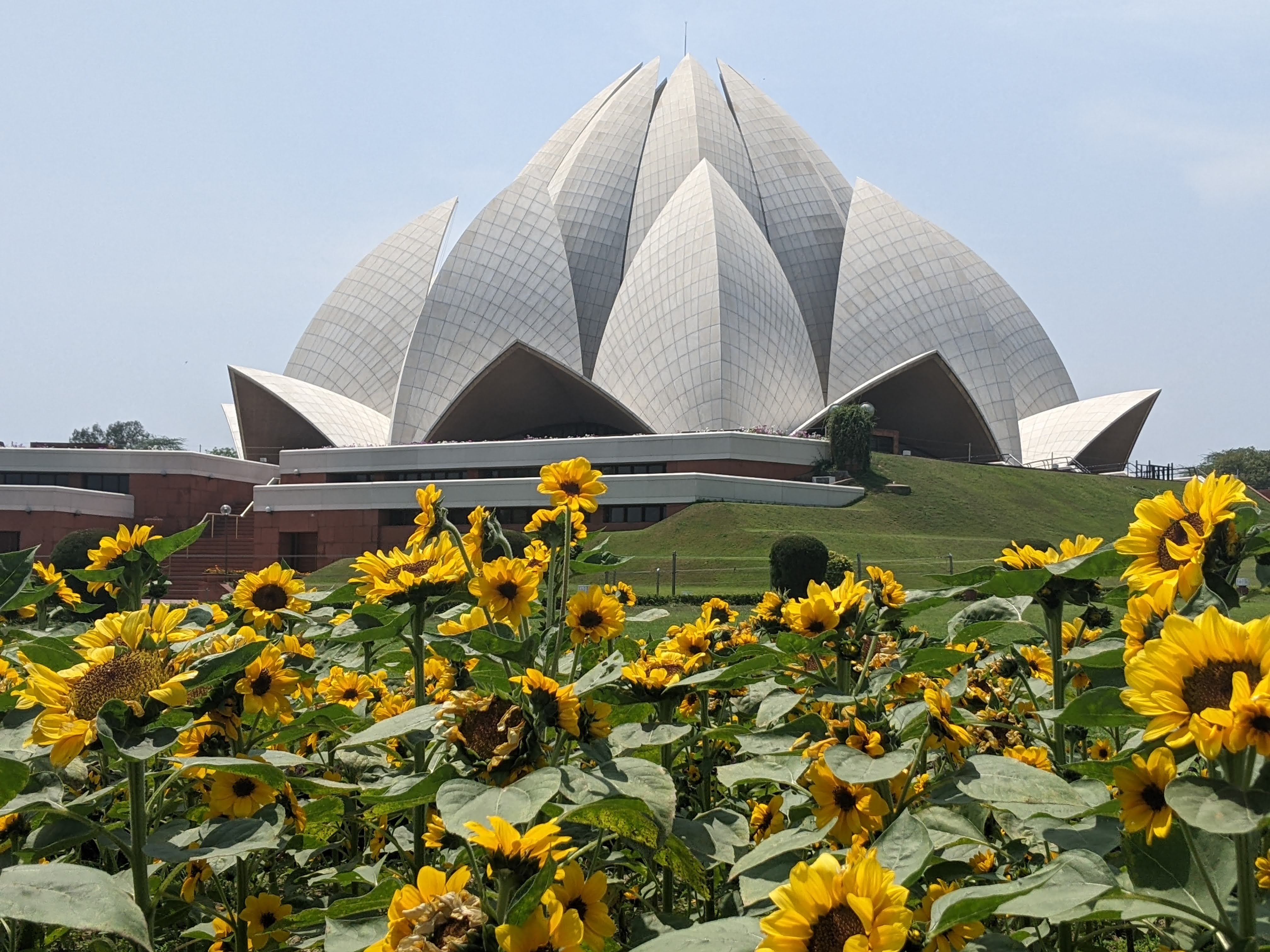 A Lotus among sunflowers, on a hot day.
A Lotus among sunflowers, on a hot day.
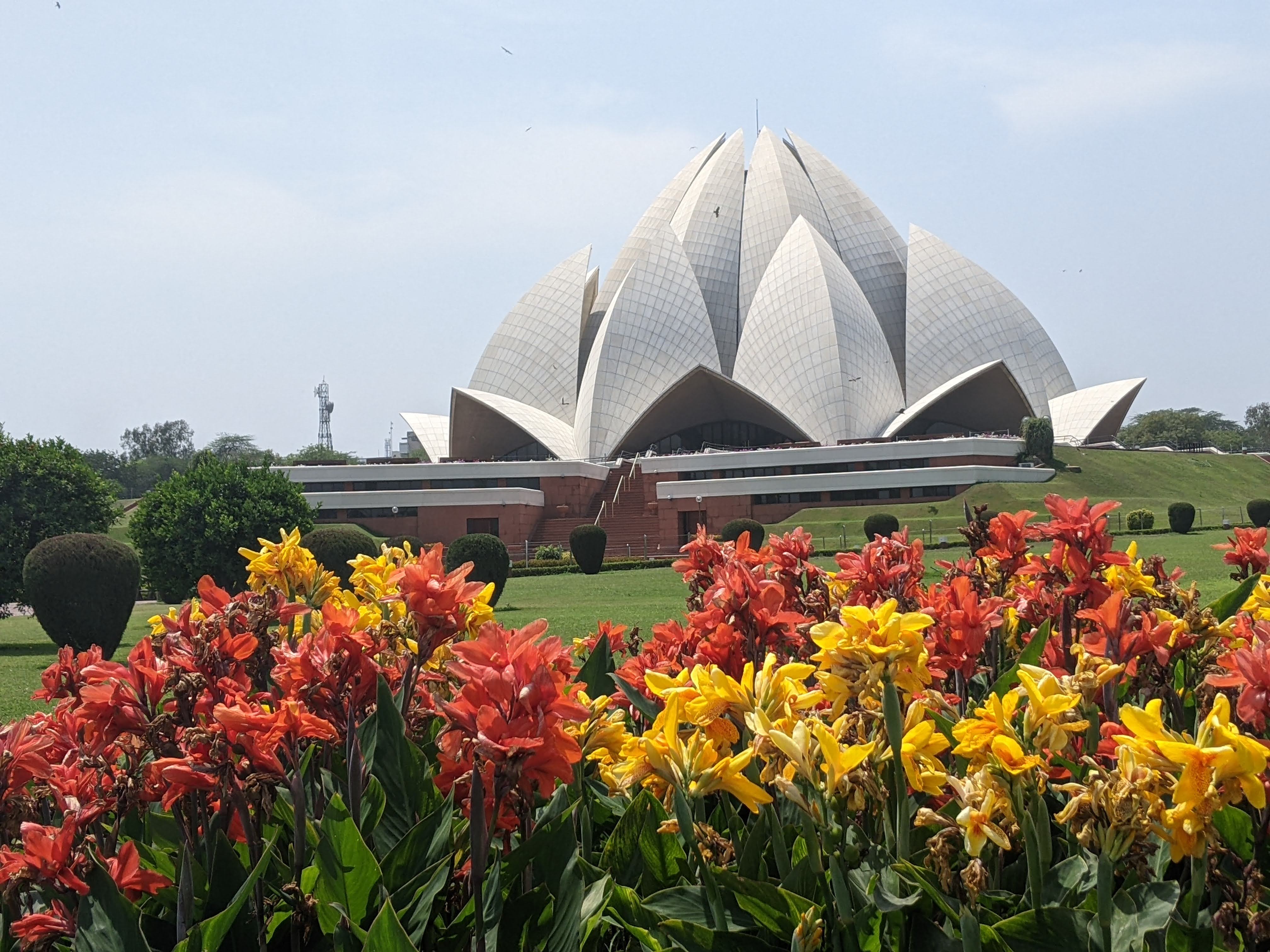 Lotus among Canna Lily.
Lotus among Canna Lily.
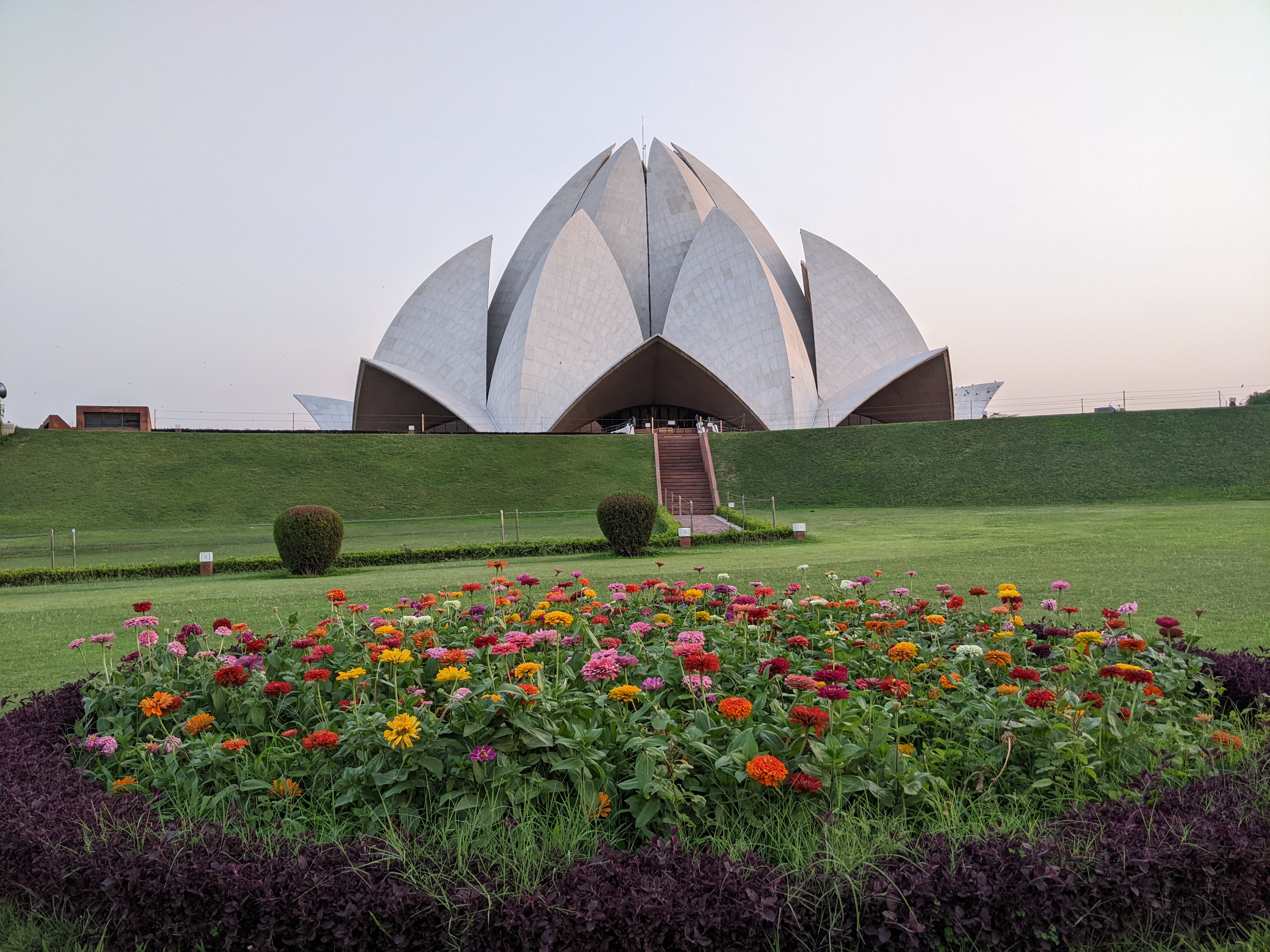 Another view of the temple from the gardens.
Another view of the temple from the gardens.
SATURDAYS AND SUNDAYS
Saturdays and Sundays were the days when I saw the largest number of visitors. There were Sundays when the crowd was very huge. Unable to manage the crowd on one Sunday the temple hall was closed to the public in the afternoon but they were allowed to freely explore the temple grounds and exit through the back exit. On a few Sundays, the parents who were immersed in taking photos had lost their children, and we as volunteers found the children wandering away or crying would take them into our fold, and waited for the traumatic parents to approach us. After verifying their identity, we released their children to them. There were also some emergency situations when we had to provide first aid assistance.
A rush on a Sunday.
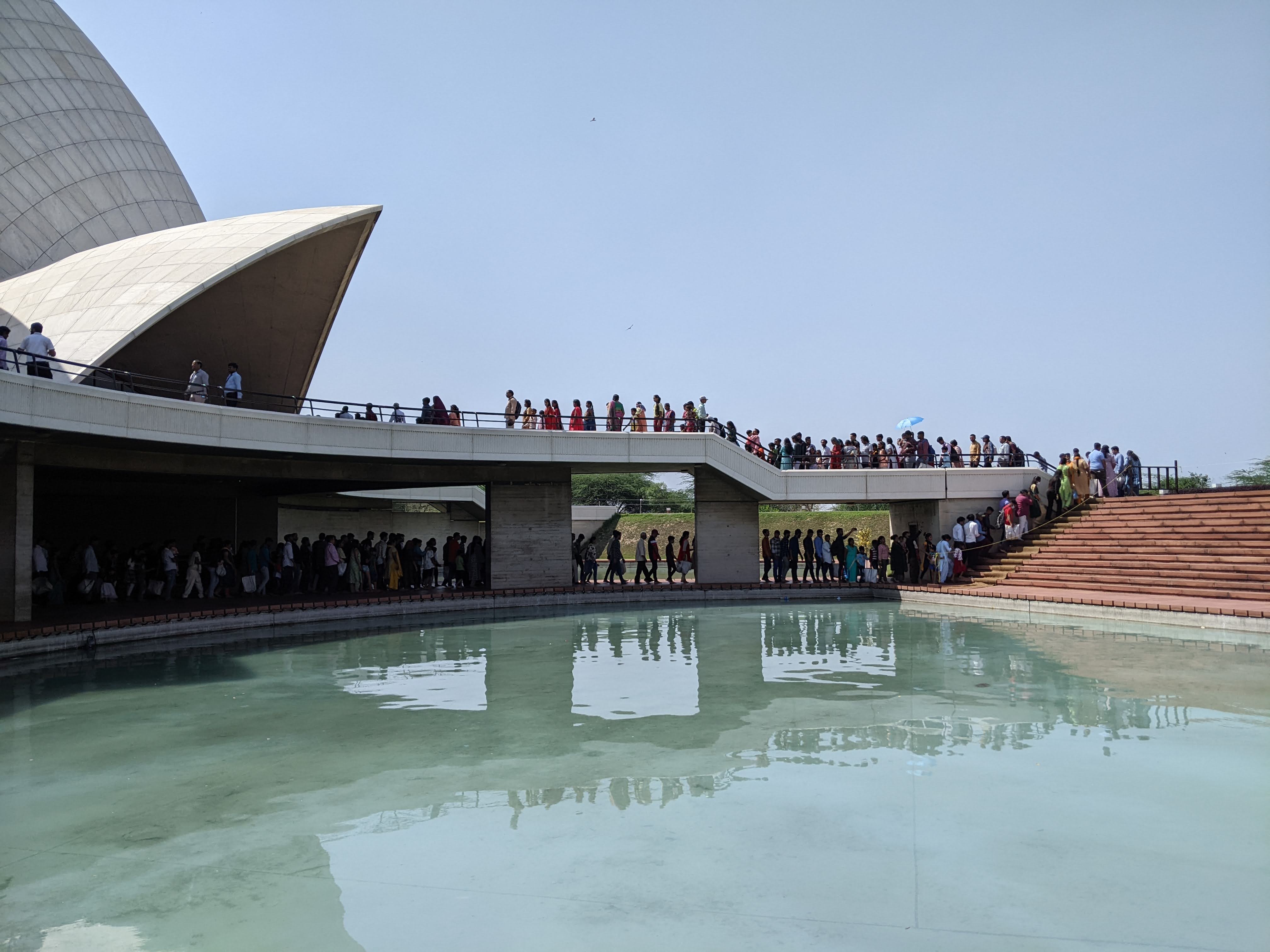 Diverting the crowd to below the temple on then back to the prayer hall on a typical rush day.
Diverting the crowd to below the temple on then back to the prayer hall on a typical rush day.
INFORMATION CENTRE
Part of my duty was to serve in the Information Centre situated right opposite the temple, close to the main entrance gate itself. Visitors to the Information Centre were mainly those who were interested to know about the Faith and the temple. They were either referred to the Information Centre at the temple or walk-in directly on their own. As a volunteer, I was told to beef up my knowledge as many kinds of detailed answers would be expected from the visitors. On the first day, I went to the Information Centre early and went around the zones to study the panels and get a deep understanding so that I would be well-equipped to answer the questions from the visitors. I saw many photos the like of which I had never seen before, and the explanations given were so graphic and well-detailed.
The Information Centre was opened to the public in 2003. It was designed by the same person who was the architect of the temple. This is a self-teaching centre for those who wish to get an in-depth knowledge of the Baháʼí Faith. As praying and meditating are the main purpose of the temple, we do not engage in teaching the Faith at the temple itself. However, should anyone show interest in knowing more about the Baháʼí Faith they are directed to the Information Centre. It contains hundreds of eye-catching photos and display panels. As one exits the Information Centre, he or she would be well-informed of the basic tenets of the Faith. There are two large auditoriums within this Information Centre, where Baháʼí films were screened on special occasions. The Information Centre has four zones. At Zone One which is at the entrance, one could see illuminated panels containing scriptures from several religions and a display of major books of the Faith. There is also a model of the upcoming Baháʼí temple in Bihar Sharif in Bihar state. There is also a bookshop for the public to purchase books and posters of the Baháʼí temple. Zone Two has panels and photographs of the history of the Faith and holy places associated with the Faith and a mini model of the temple. Zone Three has photographs of all other Baháʼí Houses of Worship across the globe, some monarchs to whom Bahá’u’lláh wrote letters, and some early leaders of India who were associated with the Baháʼí Faith. At the end of Zone Three, there is a mini museum that contains some original tools used for the construction of the temple and photographs of the construction of the temple. Zone Four displays photographs of the Baháʼí community in India and abroad involved in socio-economic projects ranging from rural education of women to self-supporting to health programs and schooling, to name a few. A visitor has to come back to the exit where there is a desk to sign in the guests’ book or to collect pamphlets in the language of their choice, as well as prayer cards – all at no cost. Many visitors sign in the guests’ book with highly positive remarks and comments. Some of them even leave their details to be sent more information on the Faith.
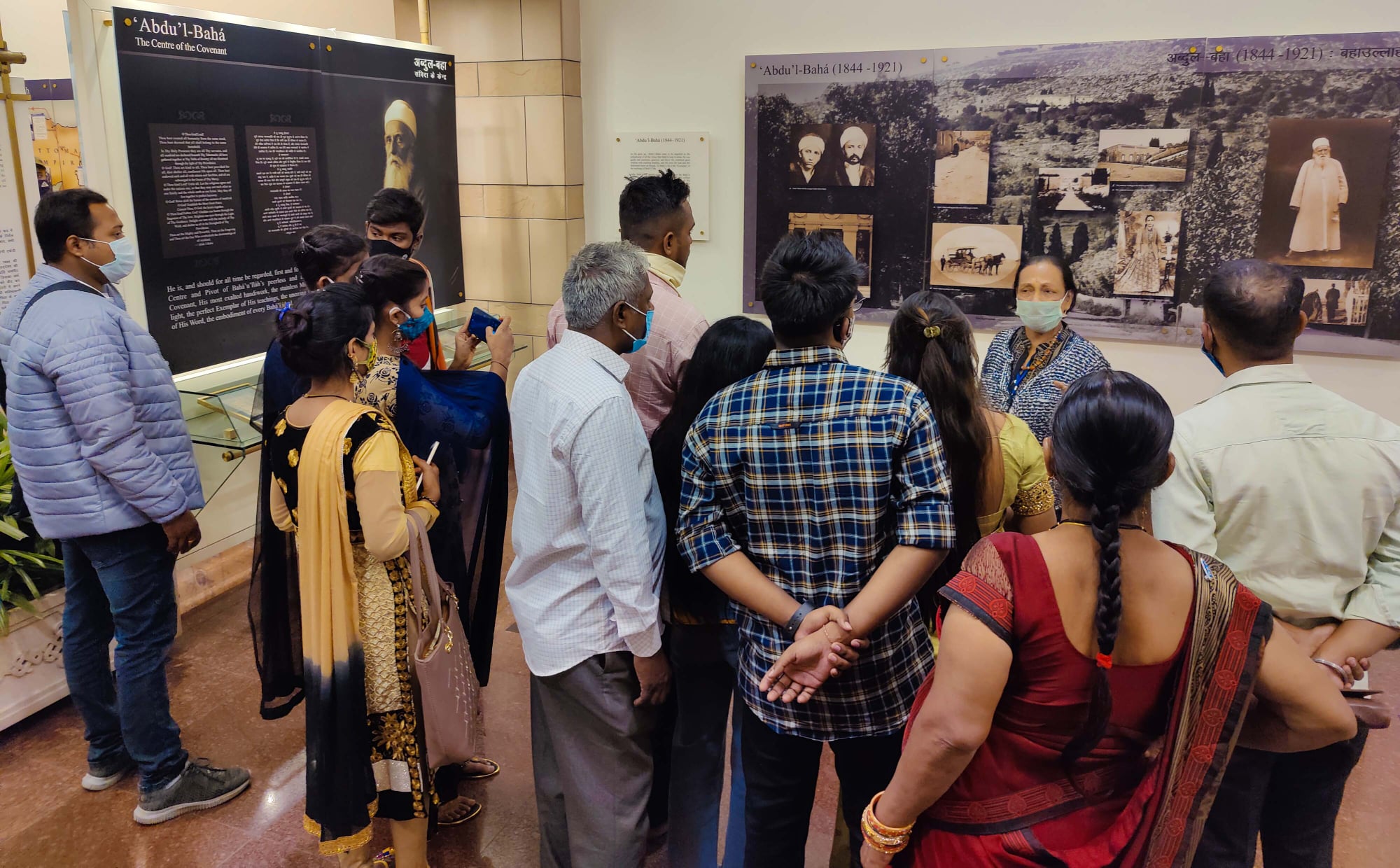 A volunteer briefing at Zone One at the Information Centre.
A volunteer briefing at Zone One at the Information Centre.
Although the Information Centre is self-teaching, there are several volunteers to assist in giving detailed explanations on a needs basis on what is being displayed. I gave explanations in English, Telugu, and Tamil depending on what language the visitors spoke. Here the visitors had more time to listen as the atmosphere was quiet and fans were running to keep the place cool. A visit to the temple would be incomplete without a visit to this Information Centre. Attached to the Information Centre is the Office of Public Information. This office plays a key role in giving detailed explanations to those visitors who are eminently placed in society. When such eminent visitors arrive at the temple, the Director of the Office of Public Information would provide a guided tour of the temple and the Information Centre. Numerous have been eminent people who had been given such guided tours.
GROWING NUMBER OF PUBLICATIONS
The age of the temple was thirty-seven years and eight months when I served as a volunteer. And the temple has grown by leaps and bounds over the years and has emerged from obscurity. With the advent of the internet, much publicity is there for this astounding edifice. By 2003, the Baháʼí World Centre Library based in Haifa had archived more than 500 publications that carried information on the Lotus temple in the form of articles, interviews with the architect, and write-ups extolling the structure. At least two major books, to my knowledge, have been published exclusively on the temple. They are: Forever in Bloom: The Lotus of Bahapur published in 1992 and The Dawning Place of the Remembrance of God published in 2002.
ACCOLADES
Again, over these thirty-seven years, so many pleasant things have been written on the Baháʼí House of Worship in India by various parties. Accolades started pouring in from within one year of the existence of the temple. The following are but some:
- In 1987, Fariborz Sahba, the architect of the Baháʼí House of Worship, was presented the “Award for excellence in religious art and architecture” by the UK-based Institution of Structural Engineers for producing a building. It said the temple is “Emulating the beauty of a flower and so striking in its visual impact”.
- In 1987, the Interfaith Forum on Religion, Art and Architecture, Affiliate of the American Institute of Architects, Washington, D.C., gave their “First Honour award for “Excellence in Religious Art and Architecture” to Fariborz Sahba for the design of the Baháʼí House of Worship.
- In 1988, the Illuminating Engineering Society of North America conferred the Paul Waterbury Special Citation for Outdoor Lighting for the “Taj Mahal of the Twentieth Century”.
- In 1989, the temple received an award from the Maharashtra-India Chapter of the American Concrete Institute for “Excellence in a concrete structure”.
- In 1990 recognition came from the American Concrete Institute as “One of the finest concrete structures of the world”.
- The 1994 edition of Encyclopædia Britannica, in its “Architecture” section gives recognition to the temple as “An outstanding achievement of the time”.
- In 2000, the Architectural Society of China praised this edifice as “Ane of 100 canonical works of the 20th century” in “World Architecture 1900-2000: A Critical Mosaic, Volume Eight, South Asia”.
- In 2000, the GlobArt Academy based in Vienna, Austria, presented its “GlobArt Academy 2000” award to the architect of the Lotus temple, Fariborz Sahba, for “The magnitude of the service of this Taj Mahal of the 20th century in promoting the unity and harmony of people of all nations, religions and social strata, to an extent unsurpassed by any other architectural monument worldwide.”
- It has been declared a “Symbol of Communal Harmony” in the international Incredible India campaign conducted by the Ministry of Tourism, Govt. of India.
Other appreciations were: “A power icon of great beauty … an import symbol of the city,” and “An extraordinary feat of design, construction, and appropriateness of expressions.” The BBC in 2016 mentioned this as “The world’s most beautiful places of worship”. It is also placed under UNESCO Cultural Heritage.
A PRIDE OF CULTURAL DIVERSITY
The greatness of India lies in that it welcomes all beliefs and religions that promote the well-being of mankind. In 2011, coinciding with its 25th anniversary, the Bahá’í House of Worship in New Delhi was featured on posters in fourteen countries, from South Africa to Japan, the USA to Singapore. It was part of an Indian government’s campaign to showcase the cultural diversity and special achievements of the country. Leaders of India also placed on record their appreciation. The Honourable Union Minister for Tourism, Subodh Kant Sahai commented, “India represents the spirituality of all mankind and the Bahá’í temple is the one place where people belonging to any faith or religion can go for meditation or prayer.” Sultan Ahmed, the Honourable Minister of State for Tourism said, “This is a unique place to be visited. It has world-class architecture, serene surroundings and an elevating atmosphere”. Mrs. Sheila Dikshit, the then Honourable Chief Minister of Delhi said “This is a beautiful building. It has become an iconic symbol. The appeal of the temple is that it encompasses everybody.”
Speech by Mrs. Sheila Dikshit, the then Honourable Chief Minister of Delhi.
LOST IN WORDS
Against what these eminently placed leaders have said, my own words fade into insignificance. Yet I wish to mention my heartfelt emotions and feelings for a beauty of a rare kind I have witnessed. The temple has its own beauty that cannot be described in words. One volunteer from abroad who arrived by plane had this to say, “When the plane in which I was travelling was about to land, I looked through the window and had the most beautiful view of the temple. That view from the air was fabulous!” So, the temple is beautiful when viewed from the air and from the plains. As I viewed the temple from different places, different angles, and different distances, it appeared majestically beautiful. And during different times from dawn to dusk, the temple presents itself with an enchanting beauty. As the sun sets, the temple is illumined for an hour or so, which is again most eye-catching and soul touching. The temple has breathtaking sceneries, as it stands in the midst of emerald greenery with undulating landscaped gardens with manicured lawns and flower beds, adding a serene and pristine touch to the hearts of one and all. This temple offers an environment for people of all religions to come together and pray together.
MEMORIES THAT SHALL REMAIN FOREVER
While serving in the temple, I also found time to pray with all my heart. It was an educational experience for me. Learning about the temple from home or from the internet or other publications is not the same as being in the service at the temple. It is while serving there that I gained so much information hitherto unknown, and so much inspiration as never before. 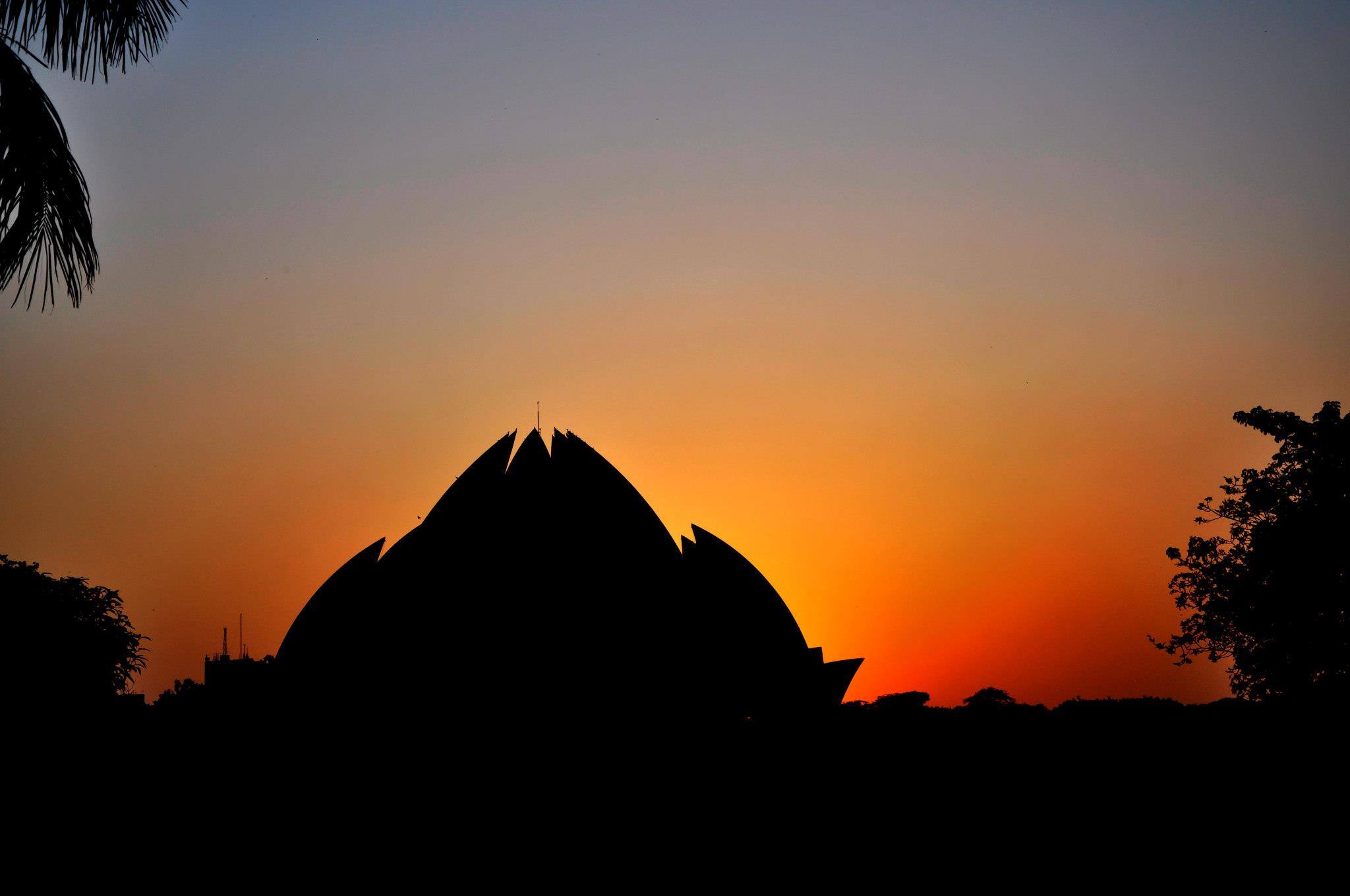
A spiritual beauty at sunset.
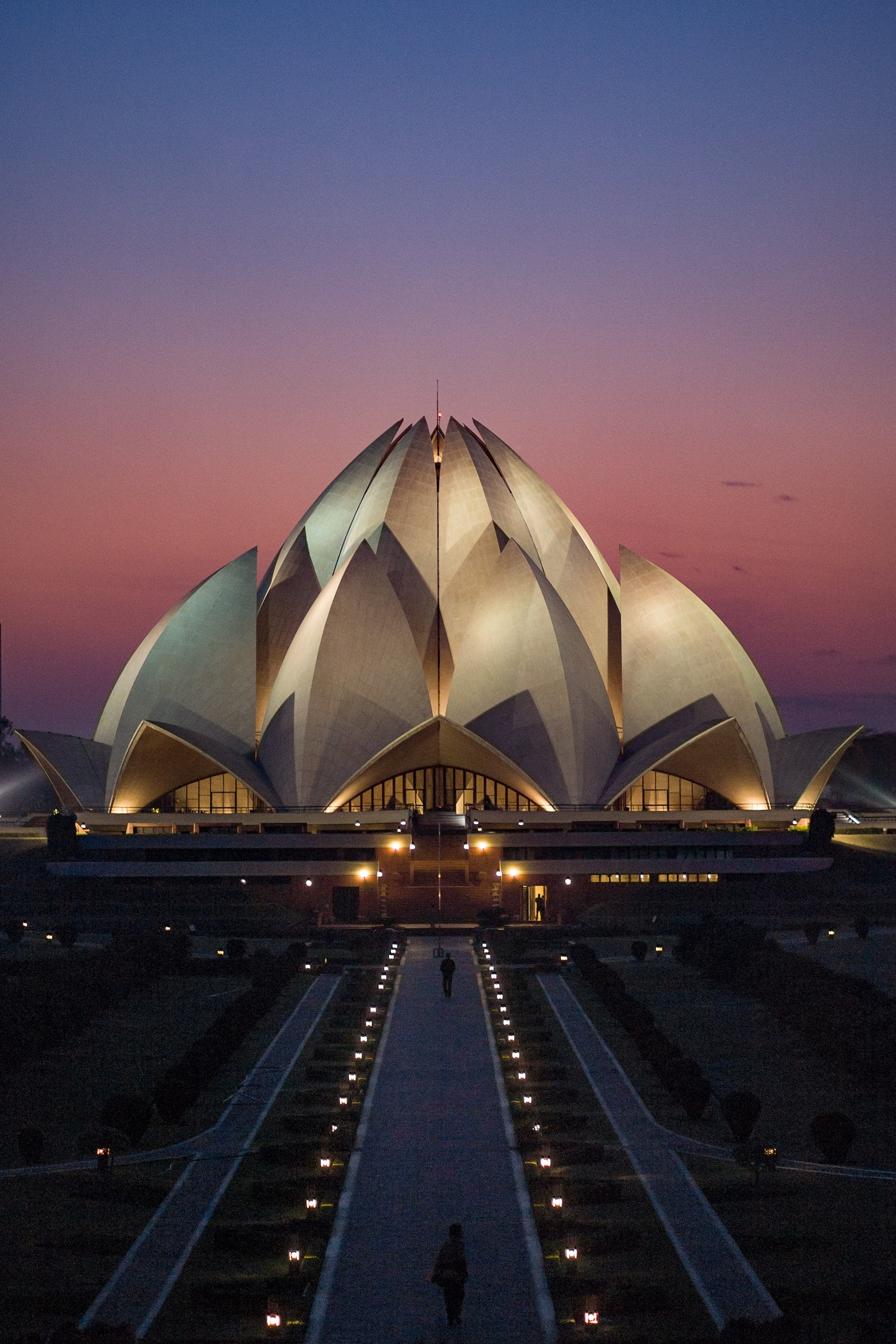
As the night begins.(Copyright © Bahá’í International Community)

Simply glows against the sky at night.
The temple offered me a level of spiritual calm that I had never experienced before. ʻAbdu’l-Bahá, explains that the Baháʼí House of Worship is a material structure that has a spiritual effect and has a powerful influence on every phase of life. How true! It is not only the memory, but the spiritual impact too has found a permanently reposing place in the innermost corner of my heart. Days passed like a fleeting moment and when the service ended, we all returned home, leaving our hearts forever in the Baháʼí House of Worship in New Delhi – the Dawning Place of the Praise of God.
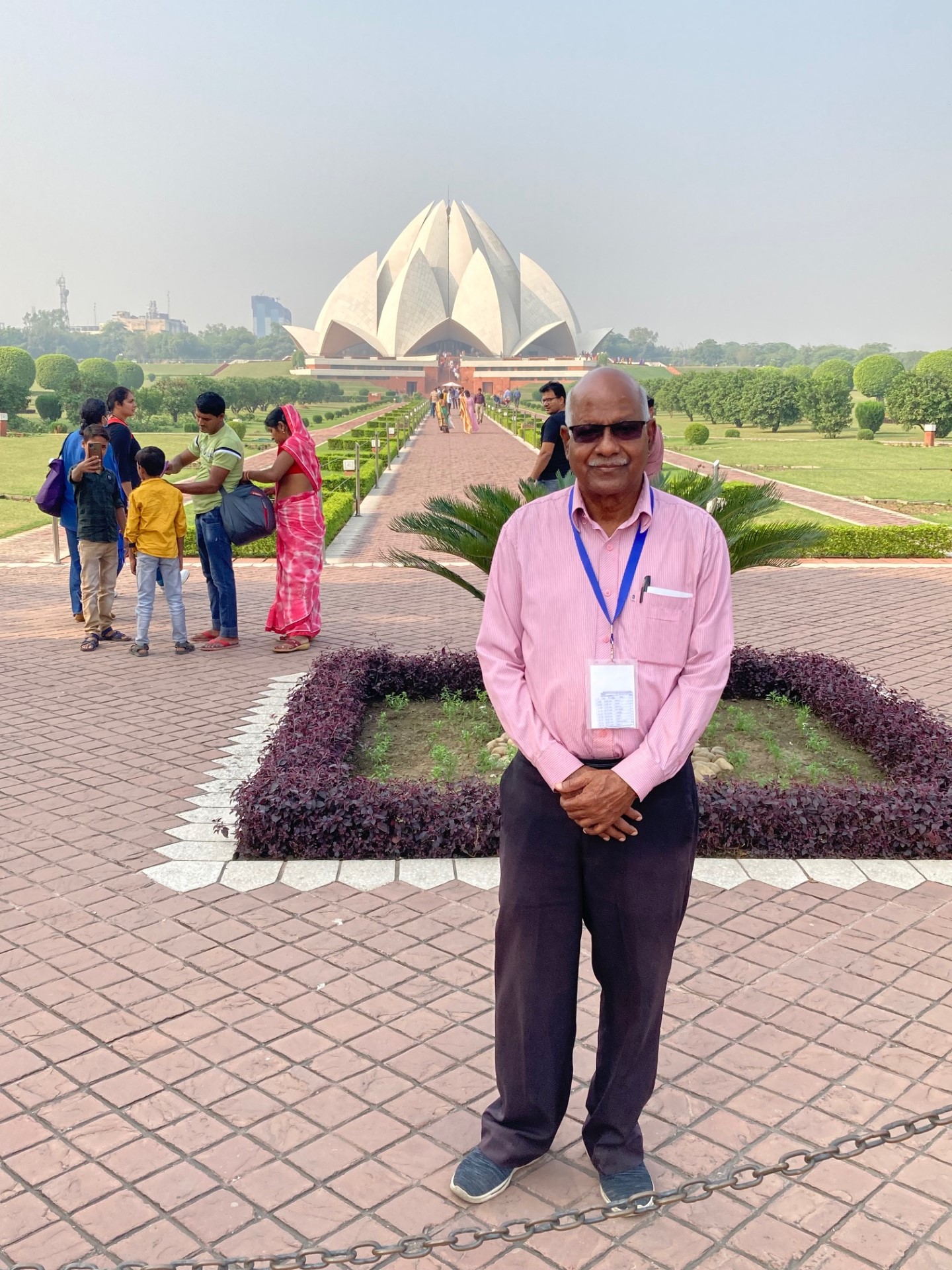 Memories of the Baháʼí House of Worship in New Delhi shall forever be etched in the innermost corner of my heart – the author.
Memories of the Baháʼí House of Worship in New Delhi shall forever be etched in the innermost corner of my heart – the author.
Mari Yariah
Ipoh, Malaysia
30 June 2023
Copyright©bahairecollections.com
You may leave your comments at: info@bahairecollections.com
30 thoughts on “TWO MONTHS AT THE LOTUS TEMPLE”
I recently came across a thought-provoking message in one of my WhatsApp groups that said, “A tight hug and a soulful conversation can solve a lot of problems.” To me, reading about Mr. Mari Yariah’s act of service is like engaging in a meaningful conversation. It resonates with the deep connection and sincere service one has toward his/her creator. Despite spending only two months, the author managed to gather detailed information from his first-hand experiences serving at the iconic landmarks and continental Mashriqu’l-Adhkár of the Indian subcontinent. I found his account truly valuable and believe it can serve as a guide to others.
I vividly recall serving twice at the Continental House of Worship in Kampala, Uganda, and thrice at the first Local Bahá’í House of Worship in Africa, Matunda Soy, Kenya. Additionally, I had the privilege of serving with my family at the first Local Bahá’í House of Worship in Battambang, Cambodia. Those beautiful days are truly incomparable to anything else in this world. I feel incredibly fortunate to have had the opportunity to serve at these historic edifices.
From the vision of ‘Abdu’l-Bahá, the Mashriqu’l-Adhkár is one of the most vital institutions in the world, encompassing many subsidiary branches. While it functions as a House of Worship, it is also connected to a hospital, a drug dispensary, a traveler’s hospice, a school for orphans, and a university for advanced studies. These five components are associated with every Mashriqu’l-Adhkár. I eagerly anticipate the realization of these subsidiary branches and the positive impact they will have in the unification of mankind.
I was deeply moved by the speech of Mrs. Shelia Dikshit, the Chief Minister of New Delhi, which was truly extraordinary. I had never before heard such an inspiring account from a person in a position of authority. She shared that her granddaughter expressed a desire to become a Bahá’í follower when she grows up. When asked why, her granddaughter explained that while others are engaged in various conflicts, it is only the Bahá’ís who truly love and embrace everyone without limitations.
As guests of Bahá’u’lláh, we are reminded by the wise words of ‘Abdu’l-Bahá, “See ye no strangers; rather see all men as friends, for love and unity come hard when ye fix your gaze on otherness… For each of the creatures is a sign of God, and it was by the grace of the Lord and His power that each did step into the world; therefore, they are not strangers but in the family; not aliens but friends, and to be treated as such.”
“Know that nothing will benefit thee in this life save supplication and invocation unto God, service in His vineyard, and, with a heart full of love, be in constant servitude unto Him.” As ‘Abdu’l-Bahá wisely stated in the Bahá’í World Faith (p. 374-375), these acts of devotion and service are of utmost importance. May these words resonate deeply within us, motivating us to embrace acts of service and imbue our lives with purpose and spiritual significance.
I sincerely pray and hope that these beautiful recollections will serve as an inspiration for countless individuals to engage in acts of service, regardless of their duration. Every opportunity, whether short or long, holds immense spiritual value and contributes to the enrichment of our lives.
With loving Bahá’í greetings,
Vela Gopal
Phnom Penh
Cambodia
Dear Sir ,
The article is very informative and well written. It depicts the author’s feelings so vividly
The story and the beautiful photos add spirit.The best thing I liked was the inclusion of the talk given by Mrs Sheila Dixit, the then Honourable Chief Minister of New Delhi. I am going to use this talk to send to friends of the Faith whom I want to introduce the Faith.
God bless Mr. Yariah for his endeavours in Penning down his experience.
Warm regards,
Abbas Amreliwalla
India
Mari,
It was really good to read your document. It reminds me of my own days I spent in the temple. And also you mentioned all the history of temple with pictures, it makes me more eager to read further… The document (Two months At The Lotus Temple) will help those friends who willing to serve in the temple and also those who are still not able to visit the Temple. This is the complete guide for future volunteers.
I want to read many more experiences of your services of Baha’u’allah.
Thank you and God bless you.
Joy Wahengbam
Kumbi Cluster
Manipur
India
Dear Mari
Thank you so much for the most wonderful story you have written on serving in the Lotus Temple. The story was most inspiring above anything else. I read a lot of information therein hitherto unknown to me. It was like taking a personal tour to the temple. This story will serve as a perfect guide and guidance to anyone who wishes to serve there in the future. I feel this story should be sent to the Temple Management to include some aspects into their own guidebook.
Well done!
Ganavathi Naidu
Kuala Kerai
Kelantan
Malaysia
Dear Mari
Thank you for the beautiful and detailed explanation of your service at the Lotus Temple. Very informative and highly inspiring.
Minoo Fozdar
Sydney
Australia
Dear Mari
That was an excellent perspective of serving in the Lotus Temple. Experiencing service and being part of building the New World Order is a privilege. You are one of the stars in the heaven s of understanding the Glad Tidings of Baha’ u’ llah. Congratulations!
Panjawarnam Ganesan
Subang Jaya
Selangor
Malaysia
Dear Mari
Thank you so much for this moving story.
Your story as a volunteer gives me a memory of your wonderful service at the Lotus Temple. You must have met many Bahai friends from Malaysia and elsewhere you made there. That is one place where hundreds of long long friends meet up and new friends are made as well. It is a great privilege to serve in the Temple. Not everyone gets a chance. You are one of those who made it.
May Bahaulah bless you and family.
Thanks
Rose Ong
Singapore
The story of two months of intensified devoted service at the House of worship is both in New Delhi is highly informative and very inspiring too. Having the bounty of visiting the Lotus Temple several times alone and sometimes with friends and spending many hours inside and the outside the Temple I have never known of such a detailed information of quality that this article has provided. Thank you, Mr. Mari for penning this wonderful article. Your story portrays not only the Temple’s architectural marvels, day to day activities, beauty, unifying power of accommodating people of religions and creeds, and its magnetic attraction and holiness. I was moved to read the incident of a desperate woman who cried to go into the temple for praying when the doors were closed owing to heavy rain.
Kind regards,
Dr. Firaydun Mithaq
Chieng Mai
Thailand
Dear co-worker Mari,
That was indeed an excellent write up covering most of the aspects of the Volunteer Service at the Lotus Temple. It brought back fresh memories of the time you, Gunasegaran and I served as volunteers at the Temple for two months. Time flew off but memories stay on. Your story is very comprehensive, accurate and well detailed.
Offering service at the temple is a noble work and forms part of teaching activity. It benefits the volunteer although he or she may not be aware initially. It is here that the mind opens up for fine tuning for later life. The volunteer becomes more mature and more knowledgeable in handling people and difficult situations.
During my time of service with the writer of the story Mari I observed that many volunteers came with single mind of teaching the Cause at the Temple, but I was surprised to realize that service came in a varied form- guiding visitors, security services, gardening, housekeeping etc.
The volunteer selects the field where he or she has a liking for.
I noticed also volunteers serving at the kitchen especially those who are good cooking. They were helpful to the chefs there who need to prepare 3 meals a day for at least 30 persons and the numbers would be higher during special functions. I saw that the task of the chefs here was highly demanding and challenging – more than other volunteer services.
Regards,
Magesvaran
Kota Kinabalu
Sabah
Malaysia
Thank you very much for the story on the Bahai House of Worship in India. Mari has written a very detailed story and it also takes the form of a detailed report. Now that I am inspired by the story I plan to visit the Lotus Temple this November with some Baha’i friends.
Cheng Jooi Sey
Alor Star
Malaysia
Mari has done a wonderful job in writing about the spiritual majesty of the Lotus Temple. I visited the site when the construction was taking place in 1985. I have also attended the Dedication Ceremony in December 1986. It was an honour and privilege to be at that historical dedication ceremony that was graced by the presence of three Hands of the Cause of God- Amatul Baha Ruhyyih Kahanum, William Sears and Collis Featherstone. I visited again about ten years ago. I take great pride in that all my children have served as volunteers at the temple after finishing their schooling.
The temple is the greatest teacher with millions visiting every year. Must thank you Mari, for writing this wonderful story, containing your spiritual experience while serving in the Temple. This story is well documented and will serve as the blue print for future volunteers.
God Bless you Mari
Professor Dr. Ananthan Krishnan
Puchong
Selangor
Malaysia
When I was in my primary and lower secondary schools, there was a call for funds for the construction of the Bahai House of Worship in New Delhi. My father told me that I should pledge a sum of money saved from my pocket money every month. I was initially reluctant , but I did fulfill my pledges and contributed to the Temple funds. And every time I see the photo or story of the temple, I am very proud that , like millions of Baha’is around the world, I had a tiny part in contributing to the construction of the Lotus Temple.
I read with interest this sharing of two months experience by my dear Uncle Mari as a volunteer at temple, there are some new details I have learnt today and some photographs giving other perspectives of the Temple.
I have rarely read articles from the perspective of the volunteers at the Temple but mostly have listened to verbal sharings of their experience. It is interesting to note how passionately Uncle Mari has written of his two months journey as a Volunteer with his Malaysian friends. I somewhat learnt the volunteer’s routine and challenges as well as the advantages of knowing multiple languages. I wish that someday I could do the same thing, volunteering at the temple.
My beloved Uncle Mari is always an inspiration to me in the path of service to the Cause of Baha’u’llah, here’s a man who gave almost 50 years of his life in the path of service to this Cause, serving the indigenous community, and being primary link between them and the National Institution, served as Auxiliary Board member for the Central region, in recent years as travel teacher to Miri and Brunei and now accomplished service as volunteer in the Lotus Temple. You are truly an inspiration dear Uncle Mari.
May you receive abundant blessings from the Blessed Beauty.
Vijay Saravanan
Subang Jaya
Selangor
Malaysia
Dear Mari Yariah,
I admired you presenting all your feelings and thoughts about your two months of service at the Lotus Temple!
It was really lively to read. I too have visited the temple many times. I had a chance to do only one day service in the prayer hall with my younger brother when we went there.
Although I had been there several times I have to truly admit that I have collected so much information only from your write up. I am very excited to read about the message of 2000 books in different titles in 111 languages about our Mother Temple. The explanation about the 4 zones in the information centre was well written with more details. I read with pride the various accolades showered upon the temple and I felt so proud of that.
I attended the 25th Anniversary of the Temple with my seven family members. It was unforgettable. I appreciate you especially for the spiritual and delightful pictures of the temple and the video of the speech by Mrs. Sheila Dikshith speech at 25th Anniversary Celebration.
I wish to thank of you for giving such a wonderful write up about your 2 months Temple service.
Your story will definitely I will urge so many people to visit the temple and serve in the temple.
May Baha‘u’llah Bless you!
N. Kasthuribai
Chennai
Tamilnadu
India
Dear Mari,
I was very much pleased to read such an enkindling story of the many happenings going on at the Lotus Temple. It is really heart-warming and touching by the contributions and services rendered so sacrificially by all the volunteers at the Temple. The never ending flow of tourists and visitors and those earnestly seeking spiritual strength at the Lotus were really moving to read. You have posted beautiful pictures and great videos about the friends in service. These are thrilling. The Lotus Temple has been divinely blessed. I have visited the Temple once before. Now reading your story has moved me to visit the temple once again.
Thanks to the author who have done a wonderful job .
Arumugam Thanapah
Klang
Selangor
Malaysia
What a wonderful and fantastic story that has been written by our dear Baha’i brother Mr. Mari Yariah from Ipoh, Malaysia. At the onset I must say that I have known so much about the temple, which is news to me. This story is a good guidebook by itself for future volunteers who wish to serve in the Temple.
I read the entire story in one sitting. Really, it is one of most interesting stories with his excellent experience as a two-month volunteer at the Baha’i House of Worship of the Indian Sub-Continent, popularly called the Lotus Temple which boasts of several international awards for its architectural beauty.
The many beautiful photographs of the different angles of the Temple along with the photo of with beloved Amatu’l-Bahá Rúhíyyih Khánum at the dedication of the temple in December 1986 are additional attractions to the this beautiful story.
While going through this wonderful story, I recollect that I too got the opportunity to attend the dedication of the Baha’i House of Worship from 24-27 December 1986 by Amatu’l-Bahá Rúhíyyih Khánum. I also met Hands of the Cause of God Mr. William Sears and Mr Collis Feathertone at the same event.
Earlier to that in 1984 I had an opportunity to visit the temple site when the temple was still under construction. A program was arranged by the NSA of India to visit the emple. We went from the Baha’i House in New Delhi to the temple site where the construction was going on still. Hand of the Cause of God Mr. Collis Featherstone who was with us called me to his presence at the Temple premises. He touched my shirt collar and said, “You are like a British Pilot” and conversed with me in a very friendly manner. He likened me to a pilot because I was attired all in white.
The concluding session of the dedication of the Baha’i House of Worship with public meeting was on 27th of December 1986 at the Indira Gandhi Indoor Stadium, New Delhi. There was an option for each Baha’i participant to invite two guests with guest pass. Each participant was given two passes to invite members of the public. I collected more than 100 guest passes from our Baha’i friends and invited many members of the public from New Delhi to participate the concluding session of the above-mentioned inaugural function of our Lotus Temple. One of the guests I was able to invite was one retired Lieutenant Commander, Mr. S.L. Juneja. Apparently his second son was also one the engineers of the construction of our Lotus Temple.
Thank you so much Mari for this beautiful story.
Jaya Raju Thota
Greater Visakhapatnam
Andhra Pradesh
INDIA
Reading the recollections by our dear brother Mari Yariah is very heart-warming and inspiring. The story of the 2 month service in the Lotus Temple rendered by our dear friends Mari, Gunasegaran and Mageswaren brought back memories of my own visit sometime in July 2003 with my late wife Cecilia and son Collins.
When we were approaching the temple site, I saw suddenly this magnificent building clad in white marbles. And the temple was so fabulous a sight, simply eye-catching and provided a breath-taking view. We stood still for a moment! At that time, the Information centre was not open yet. So we missed out the so many displays as related in the story. The story is so inspiring and informative that I seem to have travelled back in time. Every description in the story is so real. The author must have surely been guided to pen this masterpiece.
May many more friends arise to serve and be inspired from serving at this mother temple of the Indian sub-Continent.
Santhanasamy
Kuala Terengganu
Terengganu
Malaysia
Dear Mr. Mari Yariah
Thank you for your detailed story that well explained information regarding the Temple, its history, activities and premises.
Reading these details took me to my own days when I was serving at the Temple.
I remember making so many new friends and fondest memories which have a very special place in my heart.
The detailed information contained in the story is so much useful to the future volunteers who may have a deep burning desire to go and serve there.
Thank you.
Yours truly,
Rajesh
Sikkim
INDIA
This article, very scholarly written provides an insight into the transforming power of service at the House of Worship in India. One’s very soul is transformed. I remember my two daughters went and served in India for a period of time after completing their form five. They had so much praise and gratitude for being able to serve effectively. You go through some hardships and adjustments but in the end you do come out stronger and tougher. It is a place of beauty and splendour where opportunity abounds for service and worship.
Ranee Datwani Sreedharan
Kuala Lumpur
Malaysia
Dear Brother Mari,
Thank you so much for your very wonderful story about this great temple. I remember you serving in the temple in the months of October and November 2022 along with Gunasegaran and Mageswaren.
What you have written about your experience at the Baha’i House of Worship in your two months of service as a volunteer is very detailed and very correct. You have really observed things very well things. I do not remember any other volunteer giving a report of this depth. For that reason, I feel very good when reading your thoughts. In spending two months at the temple, you have seen all the areas of the temple, like the main entrance, information centre, pool areas, prayer hall and many more things. Your description about the visitors is excellent. I am already serving currently for the past 18 months, and your story has added more inspiration to me.
Thank you.
Sonu
Bihar
India
Dear Mr. Mari,
I have read about your two-month experience at the Lotus Temple, and I am simply amazed by your experience and the details you have given. It reminded me of a moment I had back in 2004 when I had a wonderful experience as well at the Lotus Temple. I am truly happy for you, and you are truly gifted to serve in the Temple in the name of the Supreme Almighty. When you mentioned that “A window of opportunity opened for me during the months of October and November in 2022,” it became clear that you are indeed gifted. Additionally, you mentioned that “The genesis of the temple in New Delhi began with one humble believer.” That one believer’s contribution shines through. I encourage you to continue doing whatever you can for the Mighty Cause of Baha’u’llah. Please know that you are always in my thoughts and prayers.
Isai Amuthan
Kuala Lumpur
Malaysia
Mari’s story is heartwarming and well written. Malaysian Baha’is have such a wonderful contribution, similar to the Taiwan Baha’is, just marvelous and humble. “Even atheists feel the peace “ of the temple. This is the encompassing power of Bahaullah that can touch every heart on earth if the pre-learning trappings from the past is wiped away.
Wonderful story.
John Haukness
Hankinson
North Dakota
USA
Dear Mari
Thank you for sharing your experience with details about serving as a Volunteer in this majestic House of Worship in New Delhi. Your story is very engaging, and I like the details and the photographs you included. The well -selected photographs adds value and weight to the story. Although all the photos are lovely, the one particular photo of the temple against the sunset captured my eyes most. I had a feeling of having visited the Temple in person. Thank you so much for penning this beautiful story.
Gratitude.
Nehru Arunasalam
Chicago
USA
Mr Mari
What a beautiful recollection of your service at the Mother Temple of India. Very inspiring indeed and very informative. God willing, I get a chance to visit soon and if possible serve at the temple too.
Parameswary McNeill
Subang Jaya
Selangor
Malaysia
Dear Mari,
This is a very well-written and informative account of your service at the Baha’i Temple in New Delhi. You have clearly put a lot of thoughts and efforts into your writing.
Your description of the temple’s beauty and the reverence of the visitors if great. You really captured the sense of awe and wonder that the temple inspires. I am touched by the kindness and compassion shown by the volunteers in the story about a lady who cried and begged to be allowed into the hall to pray. And also, about the Chief minister’s granddaughter’s desire to become a Bahá’í.
I also appreciated your insights into the different aspects of temple service. You clearly have a deep understanding of the importance of service, and you were able to share that understanding in a way that was both informative and inspiring. Thank you for adding the many accolades the temple received for its beauty and architecture.
Overall, this is a wonderful piece of writing that provides a unique and valuable perspective on the Baha’i Temple in New Delhi. Anyone who desires to serve at the temple should read the account of your truly inspiring service.
With loving Bahá’í greetings
Arul Nathan Suppiah
Kuala Lumpur
Malaysia
Dear Mari,
What an honour that has been bestowed upon you in your service at the Lotus Temple of India. Bless you my friend for the memories at Bahapur in service to our Supreme Lord will endure a life time.
V. Theenathayalu
Shah Alam
Selangor
Malaysia
Dear Mr Mari
Thank you for writing about your two months at the Lotus Temple in New Delhi. I too served as a Volunteer. I was just focussing on my duties but did not observe all those details that you had written. It was after reading your story that I got to know more of the various aspects of the Temple. I am happy you have spoken for all the volunteers who had served in the temple. I am sure you are echoing the sentiments of all the volunteers.
Rakhi Gautam
Lucknow
Utter Pradesh
India
Thank you Mari for your lovely story with so much interesting details on the House of Worship in India and your two months service there as a volunteer.
Being a frequent visitor to the Bahai House of Worship in New Delhi, India for the purposes of visiting and short-term services, I find that the sharing of dear Mr Mari Yariah has taken me to a greater perception. The story has covered beyond what I had seen or heard of the temple.
Most of the information contained in your story have been carefully collected. Your personal encounters and experience are quite new to me although I am quite familiar with some of them.
The story is meticulously crafted and could be considered as a great guide for future volunteers before coming and serving in the Temple.
Pandian Thangapandy
Ipoh
Malaysia.
Dear Mari,
Many thanks for sharing writing an excellent article that carried the magnificence of the Lotus Temple in New Delhi and your experience as a Volunteer there.
It was beautifully written by you with vivid details on the development, purpose and vision of the temple for the whole of humanity as espoused by Baha’u’llah. I really salute and admire the volunteers serving at the Temple with such dedication, patience and commitment to guide and explain to all visitors.
Best regards,
Dr. Leong Yow Peng
Subang Jaya
Selangor
Malaysia
Dear Brother Mari
That story of yours on the House of Worship in New Delhi is a brilliant piece of work. A very inspirational narrative, inspiring readers to do service at the Temple.
I had the blessings of attending the foundation laying ceremony by Hand of the Cause of God Amatu’l-Bahá Rúhíyyih Khánum, in October 1977. After that I have visited the Temple a few times in recent years, but after reading your well written report of your two months stay at the Lotus Temple, or what is called the “Mother Temple” of the Bahá’í Faith in the Indian subcontinent, it makes me go back again to this mother temple and follow your foot steps.
Thank you for writing this story giving descriptive details of the day in the life of a volunteer serving at the temple and sharing your story to inspire others.
Nat Yogachandra
General Manager
Bahai Publishing Trust
Wilmette
Chicago
USA
Dear Mari ,
After reading your story on your two months of service in the Bahai House of Worship in India, I could only feel proud of your commitment. Your story is so detailed and I just do not know how you were able to gather so much information while there. It appears that your spirit was so high during your service that. I could feel the spirit in your story. I am sure the readers are inspired by what you have written.
Thank you for this wonderful story
Mary Dharmalingam
Sydney
Australia